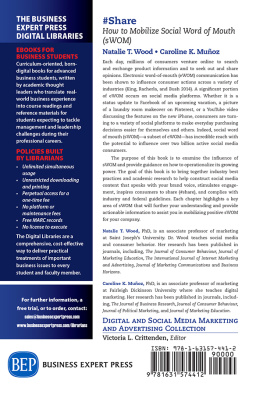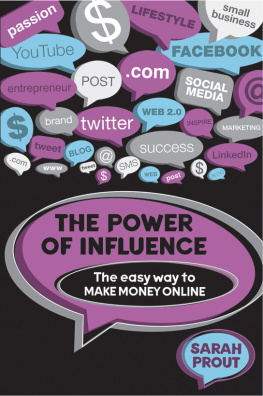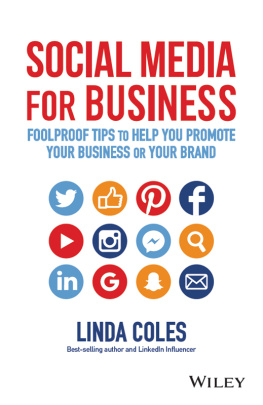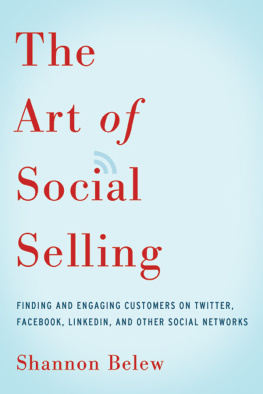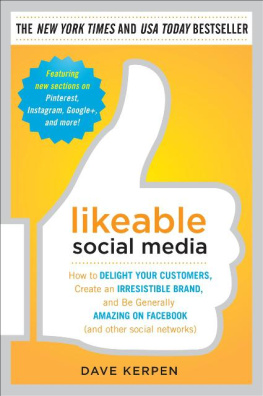
#Share
#Share
How to Mobilize Social Word of Mouth (sWOM)
Natalie T. Wood and Caroline K. Muoz

#Share: How to Mobilize Social Word of Mouth (sWOM)
Copyright Business Expert Press, LLC, 2017.
All rights reserved. No part of this publication may be reproduced, stored in a retrieval system, or transmitted in any form or by any meanselectronic, mechanical, photocopy, recording, or any other except for brief quotations, not to exceed 400 words, without the prior permission of the publisher.
First published in 2017 by
Business Expert Press, LLC
222 East 46th Street, New York, NY 10017
www.businessexpertpress.com
ISBN-13: 978-1-63157-441-2 (paperback)
ISBN-13: 978-1-63157-442-9 (e-book)
Business Expert Press Digital and Social Media Marketing and Advertising Collection
Collection ISSN: 2333-8822 (print)
Collection ISSN: 2333-8830 (electronic)
Cover and interior design by Exeter Premedia Services Private Ltd.,
Chennai, India
First edition: 2017
10 9 8 7 6 5 4 3 2 1
Printed in the United States of America.
To Timothy, Conor, Ronan, and Ava, who sometimes share too much.
To J, M, S, and my mother. Thanks for your patience.
Abstract
Each day, millions of consumers venture online to search and exchange product information, seek out, and share opinions. Electronic word-of-mouth (eWOM) communication has been shown to influence consumer actions across a variety of industries (King, Racherla, and Bush 2014). A significant portion of eWOM occurs on social media platforms. Whether it is a status update of an upcoming vacation on Facebook, a picture of a laundry room makeover on Pinterest, or a YouTube video discussing the features on the new iPhone, consumers are turning to a variety of social platforms to make everyday purchasing decisions easier for themselves and others. Indeed, social word of mouth (sWOM)a subset of eWOMhas incredible reach with the potential to influence over 2 billion active social media consumers.
The purpose of this book is to examine the influence of sWOM and provide guidance on how to operationalize its growing power. Our goal in writing this book was to bring together industry best practices and academic research to help you construct social media content that speaks with your brand voice, stimulates engagement, inspires consumers to share (#share), and that complies with industry and federal guidelines. Each chapter highlights a key area of sWOM that will further your understanding of the topic and provides actionable information to assist you in mobilizing positive sWOM for your company.
Keywords
Brand Advocates, Brand Ambassadors, Brand Endorsers, Consumer Reviews, eWOM, Facebook, Google+, Influencers, Instagram, Pinterest, Social Influence, Social Media Marketing, Social Media Policy, Social Media Regulations, sWOM, Twitter, Viral Marketing, WOMM, Word of mouth marketing, YouTube
Social media is, in many ways, akin to the wild, Wild Westlawless, crazy, messy, and sometimes, a little brutal. If you agree, feel some sympathy for us who attempt to teach this topic. Without question, social media is a fascinating subject, and lets face it, its not going anywhere. So, lets take the horse by the reigns, follow the regulatory laws, develop some order, and learn more about how you can use social media in your company. But, before we get carried away, we should warn youthis book is not a Complete Guide to Social Media (there are plenty of books that have tackled that monster). This book focuses on what lies at both the heart and soul of social media: what motivates consumers to update their Facebook status, retweet an interesting piece of news, and pin things that they will probably never make (Hello, Bourbon Brown Sugar Maple Bacon Candy!). This book focuses on a topic that is under-represented on digital and physical bookshelves. This book focuses on the topic of social sharing (#Share).
Everyday consumers are drawn to social media to share their opinions, ideas, purchases, events, recent finds, and much more with their social networks. They also use social media to find information to help them make their purchase decisions. Logically, companies are drawn to social media to reach and engage with their consumers. However, for many companies, trying to engage with consumers on social media is extremely challenging. The sheer volume of tweets, status updates, pins, and videos that consumers are exposed to every day is staggeringit is like drinking from a fire hose. Companies are increasingly frustrated that despite all their hard work, their social media efforts appear to produce little results. It is not easy getting people to like your Facebook page, retweet your news alert, comment on your video, and it is even more difficult to get them to discuss and share your posts with others.
When consumers share, they are engaging in word of mouth (WOM). One form of WOM is electronic WOM (eWOM). There is a wealth of books and websites that discuss the importance of eWOM and how to use it for business purposes. Yet, there is a big empty spot (at the time of writing this book) on bookshelves on the topic of social WOM (sWOM). Certainly, there are similarities between eWOM and sWOM; however, we suggest that we should view sWOM as a subset of eWOM. We believe that there are differencesdifferences that warrant a closer look. And, that is what we aim to do.
In this book, we discuss the importance of understanding the social consumerwho he is, what social media accounts he or she uses, why he or she uses them, what content he or she wants to engage with, and more importantly, what makes him or her want to share his or her opinion and your company message with others. We advocate that to be successful with engaging consumers in sWOM it needs to be a companywide effort. That is, your company needs to become a social business in which communicating and sharing on social media is a part of your companys DNA. Going back to our Wild West analogy, we highlight the various federal and industry regulations supporting sWOM and discuss the importance of developing a social media policy. From here, we delve into how to create content that resonates with your consumerscontent that engages them, which they feel compelled to discuss and share. We examine how to craft engaging textual stories and highlight the power of visuals. We also discuss how you can harness the powers of persuasion to encourage your consumers to share, retweet, comment, and the like. Throughout all of this, we offer examples of companies who are already succeeding in this area and provide you with resources to help your company succeed.

Figure 1.1 An example of social sharing on Twitter
Source: Courtesy of C. Munoz.
Too personal? A tweet can say a lot. And a tweet with a hashtag and an image not only communicates more, but is also much more likely to be shared. The screenshot in embodies many topics that this book will explore: the role of storytelling, the persuasive power of images, emotional appeals, personalization, and social sharing. It also marks the beginning a positive storywhich is where all good social media campaigns (and books) should begin.
In the summer of 2014, Coca-Cola launched the personalized, Share a Coke campaign. Twenty oz. bottles of Coca-Cola, Diet Coke, and Coke Zero were adorned with 250 of the most popular American names for millennials and teens. Consumers were prompted to share their photos of the personalized bottles using #Shareacoke on social media. They could visit shareacoke.com to create, then share virtual, personalized bottles on Instagram, Facebook, Tumblr, and Twitter. They could also be featured on Coke billboards by using #Shareacoke (Hitz ). Consumers were drawn to soda bottles that were emblazoned with not only their name, but also the names of their family and friends. Coca-Colas bottle personalization was putting into action something that Dale Carnegie taught us long beforeA persons name is to that person, the sweetest, most important sound in any language. So, naturally, consumers wanted to share their name discovery on Twitter, Facebook, and Instagram.
Next page
